Você está procurando uma maneira de configurar o WP Super Cache em seu site WordPress?
Mecanismos de pesquisa como o Google agora consideram a velocidade do site como um importante fator de classificação. O WP Super Cache pode acelerar a execução do seu site, impulsionar o SEO do site e melhorar a experiência do usuário dos visitantes do site.
Neste artigo, mostraremos como instalar e configurar o WP Super Cache em seu site.
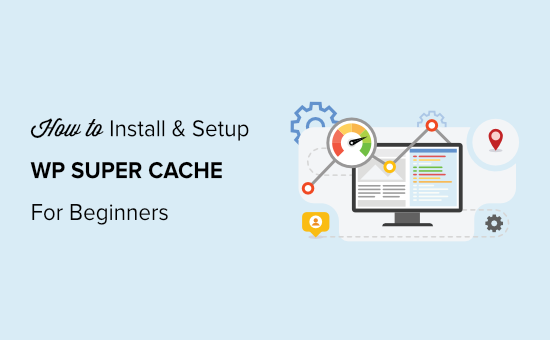
O que é o WP Super Cache e por que você deve usá-lo?
O WP Super Cache é um dos mais populares e melhores plug-ins de cache do WordPress. É um plugin gratuito e tem mais de 2 milhões de instalações ativas.
O WP Super Cache faz uma cópia de cada página do seu site na forma de um arquivo HTML estático. Dessa forma, sempre que alguém visitar seu site, a versão copiada será exibida rapidamente, em vez de gerar o site inteiro do zero.
Como resultado, a velocidade e o desempenho de seu site WordPress melhoram drasticamente. O plug-in de cache pula várias etapas nos bastidores para garantir que os visitantes não precisem esperar a abertura da página.
Com um site de carregamento rápido, você pode ver um aumento no SEO do WordPress e nas classificações dos mecanismos de pesquisa. O Google dá uma vantagem significativa a sites mais rápidos, pois usa a velocidade do site como um fator de classificação.
Além disso, você também melhorará a experiência dos visitantes do seu site. Um site que carrega rapidamente incentiva as pessoas a visitá-lo com mais frequência. Dessa forma, você obtém mais engajamento e conversões, pois os usuários passam mais tempo nas páginas.
Agora, você está pronto para configurar o WP Super Cache em seu site? Vamos descobrir.
Configuração do WP Super Cache – a maneira mais fácil
A primeira coisa que você precisa fazer é instalar e ativar o plug-in WP Super Cache em seu site. Para obter mais detalhes, você pode seguir nosso guia sobre como instalar um plug-in do WordPress.
Após a ativação, o WP Super Cache o notificará de que o cache não está ativado em seu site no momento.
Para ativar o cache, vá para Configurações ” WP Super Cache. Em seguida, na guia Easy (Fácil), clique na opção “Caching On” (Cache ativado). Depois de fazer isso, clique no botão “Update Status” (Atualizar status).
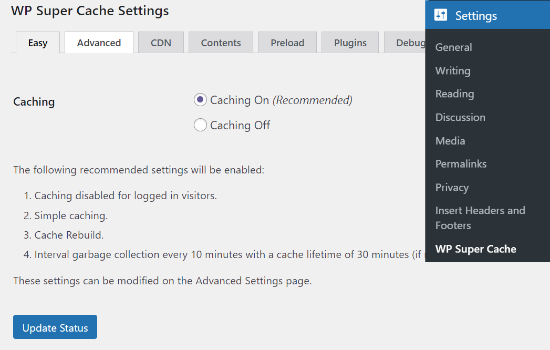
Depois de ativar o cache, você precisará rolar para baixo até a seção Cache Tester (Testador de cache).
Uma vez lá, você deve clicar no botão “Test Cache” para verificar se está funcionando.
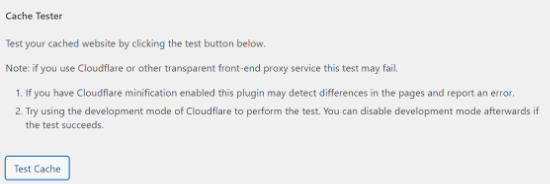
O WP Super Cache buscará seu site WordPress duas vezes e comparará os registros de data e hora das duas páginas. Se os dois carimbos de data/hora forem iguais, isso significa que o cache está funcionando no seu site agora.
Configuração avançada do WP Super Cache
O WP Super Cache é um poderoso plug-in para WordPress que vem com muitas opções avançadas. Essas opções podem melhorar ainda mais o desempenho do seu site e fornecer mais controle sobre como o plug-in armazenará seu site em cache.
Ativar o cache
Para configurar o WP Super Cache com opções avançadas, vá para a guia “Advanced” (Avançado) no plug-in WP Super Cache. Em seguida, clique na caixa de seleção “Enable Caching” (Ativar cache).
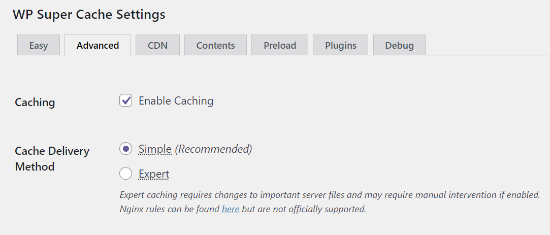
Abaixo do cache, você verá opções para “Método de entrega de cache”. Recomendamos usar a opção “Simple” se você for iniciante e não estiver familiarizado com a edição dos arquivos do servidor.
Ativar a compactação no WP Super Cache
A compactação permite que o WP Super Cache forneça arquivos em cache como arquivos compactados, o que melhora o tempo de carregamento. Esses arquivos são menores e podem ser baixados pelos navegadores mais rapidamente.
Para ativar a compactação, role para baixo até a seção “Diversos” e marque a caixa que diz “Compactar páginas, para que elas sejam servidas mais rapidamente aos visitantes”.
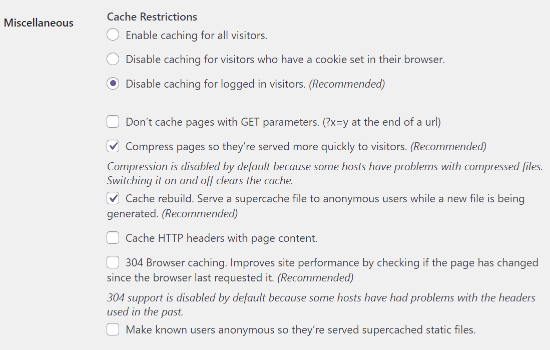
Ativar o cache dinâmico
Se você quiser manter certas partes de uma página da Web dinâmicas durante o armazenamento em cache, o WP Super Cache oferece uma opção para isso.
Para ativar a opção, vá até a seção “Advanced” (Avançado) e clique na caixa de seleção “Enable dynamic caching” (Ativar cache dinâmico).
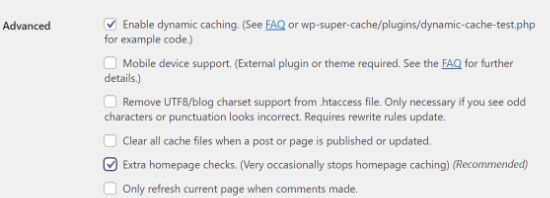
A ativação do cache dinâmico é útil em determinadas situações, especialmente se você tiver páginas com conteúdo que muda com frequência. Por exemplo, você pode acelerar as páginas que contêm anúncios permitindo o armazenamento em cache dinâmico.
Configurar tempo de expiração e coleta de lixo
O WP Super Cache permite que você configure o tempo de expiração e a frequência de exclusão de páginas em cache do seu servidor.
Para começar, basta rolar para baixo até a seção “Expiry Time & Garbage Collection” (Tempo de expiração e coleta de lixo) na guia Advanced (Avançado) para configurá-lo.
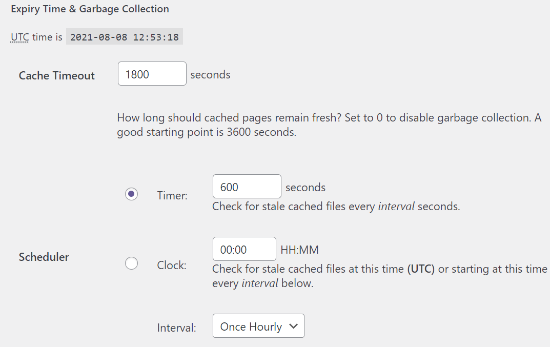
O “Cache Timeout” informa ao plug-in para remover a página em cache e executar um novo cache. O plug-in o definirá como 1800 segundos por padrão, o que é ótimo para um site de alto tráfego.
No entanto, se você tiver um site novo que não recebe muito tráfego, 3600 segundos é um bom ponto de partida.
Além disso, você pode programar um horário para que o plug-in verifique se há arquivos em cache obsoletos e os remova.
Especifique as páginas que você não quer que sejam armazenadas em cache
Por padrão, o plug-in armazenará em cache todas as páginas do seu site. Isso pode aumentar o tamanho de seus arquivos de cache e usar mais recursos. No entanto, o WP Super Cache permite que você adicione páginas que não deseja que sejam armazenadas em cache.
Você pode rolar para baixo até a seção “Rejected URL Strings” (Cadeias de URL rejeitadas) na guia Advanced (Avançado) para começar. Na caixa de texto, digite a cadeia de URLs das páginas que você não deseja que o plug-in armazene em cache.
Por exemplo, se você tiver uma loja de comércio eletrônico, poderá excluir páginas que os visitantes não visitam com frequência e economizar recursos do servidor. Essas podem ser a página de checkout, a página da conta e a página de agradecimento.
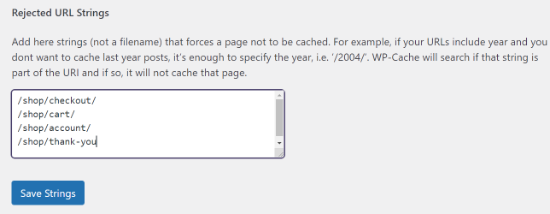
Quando terminar, não se esqueça de clicar no botão “Save Strings”.
Configuração de CDN com o WP Super Cache
A maioria dos sites de conteúdo fornece muitos arquivos estáticos em cada solicitação de página.
Isso inclui arquivos JavaScript, imagens, folhas de estilo e muito mais. Ao contrário das postagens do WordPress, que são geradas dinamicamente pelo PHP, esses arquivos podem ser fornecidos usando um serviço de CDN (Content Delivery Network).
Uma CDN é uma rede de servidores distribuídos geograficamente que ajudam a fornecer conteúdo rapidamente aos seus visitantes. Para obter mais detalhes, confira nosso infográfico sobre por que você precisa de uma CDN.
Observação: a configuração de uma CDN com o WP Super Cache é um pouco técnica e requer alguma experiência com CDNs. Se você preferir um método mais fácil, o CloudFlare é um provedor de CDN gratuito que é fácil de configurar. Veja nosso tutorial sobre como configurar a CDN gratuita da CloudFlare em seu site WordPress.
Para configurar a CDN com o WP Super Cache, clique na guia CDN e marque a caixa ao lado da opção “Enable CDN Support” (Ativar suporte à CDN).
Agora, insira seu URL externo, que será o URL da sua zona de extração. Uma pull zone informa à CDN onde encontrar seus arquivos e como fornecê-los aos seus usuários. Por exemplo, você pode digitar o seguinte: https://cdn.wpbeginner.com
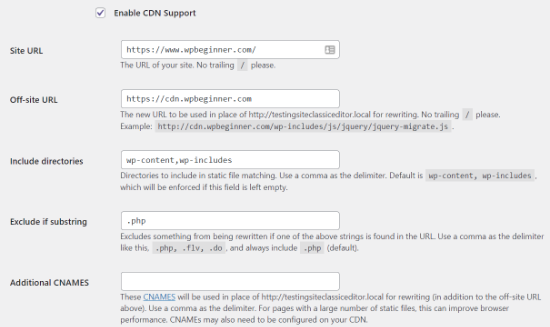
No campo Additional CNAMEs, insira outros CNAMEs que você criou para sua pull zone. Por exemplo, http://cdn1.wpbeginner.com, http://cdn2.wpbeginner.com, http://cdn3.wpbeginner.com.
Você pode deixar as outras configurações como padrão. Por fim, marque a caixa que diz “Ignorar URLs https para evitar erros de “conteúdo misto”” e salve as alterações.

Agora seu site está pronto para servir conteúdo estático de uma CDN.
Servir um site estático com o WP Super Cache
O modo de pré-carregamento no WP Super Cache permite que você crie arquivos estáticos de supercache para todas as suas postagens e páginas e sirva um site estático. Dessa forma, seu conteúdo será carregado rapidamente sempre que alguém visitar seu site.
Um arquivo estático de supercache ajuda a conservar os recursos do servidor, servir um site antigo que não está mais sendo atualizado e melhorar a velocidade do site servindo somente conteúdo estático.
Para começar, vá até a guia “Preload” (Pré-carregamento) no plug-in WP Super Cache. Em seguida, você pode definir o tempo para atualizar os arquivos de cache de pré-carregamento.
Por padrão, o plug-in o definirá para 600 minutos, mas você pode diminuir o tempo se publicar vários artigos todos os dias.
Lembre-se de que o pré-carregamento de todo o site WordPress leva algum tempo e consome muitos recursos em seu servidor. Você pode deixá-lo em 0 se não quiser que seus arquivos estáticos expirem nunca, a menos que você atualize manualmente o cache.
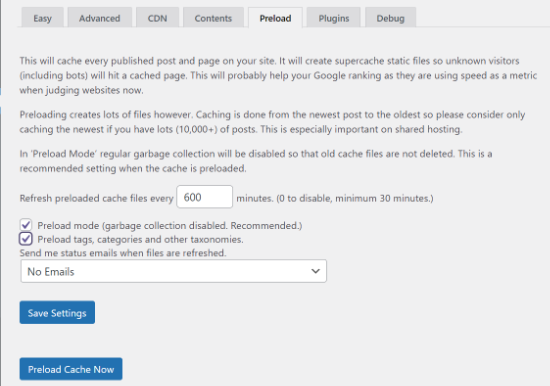
Depois disso, certifique-se de marcar as caixas para “Modo de pré-carregamento (coleta de lixo desativada. Recomendado)”. Você também pode ativar pré-carregamentos para diferentes tags, categorias e outras taxonomias em seu site.
O plug-in também oferece uma opção para receber alertas por e-mail sempre que seus arquivos forem atualizados. Por padrão, ele usará a configuração “No Email”, mas você pode alterá-la escolhendo uma opção no menu suspenso.
Quando terminar, salve suas configurações e clique no botão “Preload Cache Now”.
Guias especializados sobre o cache do WordPress
Agora que você já sabe como configurar o WP Super Cache, talvez queira ver alguns outros artigos relacionados ao cache do WordPress.
- Glossário: Cache
- Como corrigir facilmente o aviso de cache do navegador Leverage no WordPress
- Como limpar seu cache no WordPress (passo a passo)
- Melhores plug-ins de cache do WordPress para acelerar seu site
- LiteSpeed Cache vs. WP Rocket – Qual é o melhor?
- Como instalar e configurar corretamente o WP Rocket no WordPress
- Como instalar e configurar o W3 Total Cache para iniciantes
- O guia definitivo para aumentar a velocidade e o desempenho do WordPress
- Como acelerar o desempenho do WooCommerce
Esperamos que este guia tenha ajudado você a configurar o WP Super Cache em seu blog WordPress. Talvez você também queira ver nosso guia sobre como mover um site WordPress de HTTP para HTTPS ou nossa escolha especializada dos melhores provedores de hospedagem para acelerar seu site.
Se você gostou deste artigo, inscreva-se em nosso canal do YouTube para receber tutoriais em vídeo sobre o WordPress. Você também pode nos encontrar no Twitter e no Facebook.





Syed Balkhi says
Hey WPBeginner readers,
Did you know you can win exciting prizes by commenting on WPBeginner?
Every month, our top blog commenters will win HUGE rewards, including premium WordPress plugin licenses and cash prizes.
You can get more details about the contest from here.
Start sharing your thoughts below to stand a chance to win!
Greg says
Hi, I’d like to know whether your guidance to choose mod_rewrite to serve cache files still stands as opposed to using PHP or Legacy Caching. I notice since you published your article, WP Super Cache have changed their own recommendation from mod_rewrite to PHP.
Thanks in advance!
Greg
Dillon says
Hi there. I’ve followed this tutorial to a T, and for the most part, everything works correctly, but I’m having two problems. First, when I make changes, they don’t appear on the site if I’m logged in. If I log out, they appear just fine. Second, I’m working on a WPMU network, and I only have the plugin installed on one site. But it’s caching the other sites on the network as well. How do I stop it from doing that? Thanks!
Belayet Hossain says
This is an awesome guideline for new users.
It helped me a lot.
Thanks from the core of heart.
Sarah says
Hi,
I followed your steps because my site was taking over 5s to load but after setting up the WP Super Cache my site wouldn’t load. At all. It was basic HTML – no content, no pictures, just the header…
So, I guess I’m wondering if there’s a laymen’s guide to literally all the terms you use cause I don’t understand websites or programming and I have a website for a start-up NGO so can’t really pay for any help at this point.
Or maybe you could direct me somewhere that will help me understand all this better? I’m a complete novice and confused easily!
Help!
Pedro Moreira says
Hello,
I have a “conceptual doubt” about WP Super Cache, that I didn´t see answered neither in your site neither in other sites.
The question is: the structure of my site is finished. In basic terms, it is mainly a site of videos of football, which means that from this day on I will gradually add posts (that include the videos that I refered) and pages (of the teams).
Since that this will be a long and permanent process, I need right now to speed up my site because nowadays is very slow.
My doubt is: when I install and configue this plugin, what does that mean in terms of the updates that I will do in my site (post and pages that I add)?
I mean, if I cache the site today and tomorrow I add a new page or post, what do I have to do in order that these pages or posts will be also cached? – do I just have to require an update of the plugin? If so, how do I do that, is it possible to define that the plugin will update the cache for example once a week?
Thank you!
Best regards.
Bogdan says
If i don„t use set up the CDN ,the wp super cache will be work properly ?
WPBeginner Support says
Yes, it will work even without CDN.
Administrador
Herman says
I’m getting an error on the first step where you need to click on caching on and update. You mentioned the following in your article:
“WP Super Cache will fetch your WordPress site twice and will compare the time stamps of both pages. If the both time stamps match then this means that caching is working on your site now.”
This is the place where I get the error. I get a message that says:
Fetching to prime cache: OK
Fetching first copy of FAILED
Fetching second copy of : FAILED
I would be glad if you could help me out.
Sofor says
Thank you so much, It works great for me.
Teddy says
My site is a coupon site, so code is included on the coupon so it prints out by itself without lots of other junk that is on the page. If I use WP Super Cache, will that code be lost because it’s now a static page? Will people still be able to click on the coupon to print just the coupon?
WPBeginner Support says
Hi Teddy,
You will have to test it out first on your computer or in a staging environment.
Administrador
Alex says
Thanks so much for the the help. Do i have to create a cname record to use the CDN service in WP super cache. Thanks
Stefan Andonov says
Hi,
How to preload for several languages, I am using qtranslate, that seems impossible, right?
10x
Stefan
John Johnson says
This is an ecommerce site using Exchange from iThemes. With WP Super Cache activated certain pages that need to be refreshed don’t get refreshed i.e. Empty Cart. When you Empty Cart it comes back with the same content or in other words it appears unemptied.
When I deactivate WP Super Cache the problem disappears. It was suggested that I Whitelist the pages that shouldn’t be cached. I am uncertain about how to do that. Any help would be appreciated.
Regards,
John
Dajuan says
WP Beginner Staff, when a theme update is applied, or when other plugin updates are made, is WP Super Cache alerted to create new cached versions? Or does the plugin wait until “Expiry Time & Garbage Collection” or a manual cache deletion?
Iosif says
Hello,
I am using WP Super Cache, but it seems that my images don’t get cached. Any ideas on how to configure this?
I did have a lazy load plug-in, but it conflicted with my theme, so I deactivated it…
shubhendu says
I have just install wp super cache plugin by reading your article but nor js,css and image is not loading at my blog…plz help my site address is
If you dont want to publish is comment because i include my site link PLEASE reply to my email id.
Thanks.
WPBeginner Support says
Seems like you have already resolved the issue.
Administrador
madhavi jha says
hi , i am regular reader of your site , i have setup WP Super Cache plugin as you guide in your blog , but its not working its show only 20/100
please guide me ,i have been tried to solve this problem since last 2 days , please guide me .
nitai roy says
Hi,
I followed as you mentioned here. Everything has done perfectly but I could not find this option: “Enable Compression in WP Super Cache:”
Where is it please?
Also, Now how can I know whether it is working perfectly or not?
Thank you very much.
Patel Shoeb says
How to Install and Setup WP Super Cache with CloudFlare CDN?
kurakaniz says
after updating the plugin it says “.htaccess file may need to be moved” and this error too
A difference between the rules in your .htaccess file and the plugin rewrite rules has been found. This could be simple whitespace differences but you should compare the rules in the file with those below as soon as possible. Click the ’Update Mod_Rewrite Rules’ button to update the rules.
what to do please help
Ron says
Same problem here.Anyone help
stephen says
I installed everything just as you said but I am still getting 52sec load time and if I tried using gtmetrix I get an error saying the URL does not appear to be an HTML.home page . please help site is
Megan Good says
This article was very helpful, and I was able to troubleshoot my issues based on your suggested settings. Thank you for the info!
Omprakash Jaiswal says
wp super cache does not work
Permlink Structure Error
A custom url or permalink structure is required for this plugin to work correctly. Please go to the Permalinks Options Page to configure your permalinks.
Hammad says
Thank you for your suggestions, I’m trying to apply these settings on my website now. Can you please advise if wp super cache supports minify settings.
I had wp3 total cache and had a score of 97/81 on gtmetrix, after installing wp super cache my score decreased to 82/68.
Imran says
Was looking for some great guide for super cache plugin. Now I will try it on my test site.
Thanks for such a nice tutorial
Robert Connor says
Some great tips-now i need to go back and fix my site
User says
How do I get it to work for Mobile without changing the theme?
cezars says
Any info for Rejected User Agents list from the plugin ?
herb says
Installed it and got a lower grade E/D on Gtmetrix…switched to W3TC and it gave me and A/B grade.
efiga says
Hi
i have a little question , when using this plugin to cashe pages , the google adsense ads will be cashed too ? ,it will show the same ads ?
thank you in advance
WPBeginner Staff says
No your Google Ads will not be cached.
shadow says
does nothing for me
avisdupublic.net says
Hi, Thank you for this outstandly good article. However, I am facing several issues with WP S. Cache.
The website is : avisdupublic.net
1°) My Home page is a static one. However, when a new article is published, the /home must be changed (new article in the slider and so on). However, it is no the case! Moreover, when I just “update” this static page, by a strange miracle (not so strange because with the update, the cache-page is flushed), the /home becomes “normal”.
2°) From 1°), I decided to tick the Pages, Front page, Is_home in the rejected ones. However no changes appeared in the /home.
Do you have an idea where could be the problem ?
Bests,
(sorry for the poor english)
Farcas Gelu Danut says
I’m sorry for my poor English language.
I use now WP Total Cache, CDN is Cloudflare, shared hosting.
Specialists working at hosting company I recommend using wp super cache to replace the WPTotal Cache. What is your opinion?
WP Total Cache internet is recommended, considered superior WP Super Cache.
I use Google translate for this comment. Is OK?
WPBeginner Support says
Farcas, W3 Total Cache and WP Super Cache are both good plugins.
Administrador
Nguyen Duc says
Thanks for post, but i have a problem below:
Warning! Could not update /home/d2c45a95/public_html/wp-config.php! WPCACHEHOME must be set in config file.
Warning! /home/d2c45a95/public_html/wp-content/advanced-cache.php does not exist or cannot be updated.
1. If it already exists please delete the file first.
2. Make /home/d2c45a95/public_html/wp-content writable using the chmod command through your ftp or server software. (chmod 777 /home/d2c45a95/public_html/wp-content) and refresh this page. This is only a temporary measure and you’ll have to make it read only afterwards again. (Change 777 to 755 in the previous command)
3. Refresh this page to update /home/d2c45a95/public_html/wp-content/advanced-cache.php
If that doesn’t work, make sure the file /home/d2c45a95/public_html/wp-content/advanced-cache.php doesn’t exist:
1. Open /home/d2c45a95/public_html/wp-content/plugins/wp-super-cache/advanced-cache.php$wp_cache_file in a text editor.
2. Change the text CACHEHOME to /home/d2c45a95/public_html/wp-content/plugins/wp-super-cache/
3. Save the file and copy it to /home/d2c45a95/public_html/wp-content/advanced-cache.php and refresh this page.
How to fix it, bro
Joe Capone says
I have Super Cache working…the contents show all of the pages in the cache. It has increased our site speed.
the site is insuringincome.com
For some reason, when I enter additional cnames and use http://content1.insuringincome.com,….
Comma separated from content1-content10 (confirmed that all cnames are created in CloudFront districution)….I get a 404 error when saving.
I have tried many different settings…nothing prevents the 404 from trying to save with additional cnames.
Thoughts?
WPBeginner Support says
Please checkout WP Super Cache documentation on how to set this up.
Administrador
Borislav says
Hi Guys!
First sorry my English, because it is not very good!
I use wordpress and Boozurk theme version 2.02.
I have a little problem and i want little help!
The problem is: when i use my phone and surfing my site, sometimes the theme not switch to mobile view and everything in my site is with wrong view.
I also use WP super cashe plugin. When i activate the cashe and continue surf the site, then the theme not switch to mobile view and show me a desktop view of the site.
When i deactivate WP super cashe plugin and delete the cashe the view of the site on my phone is perfect. The theme switch to mobile view.
Is there any settings of WP super cashe plugin that i have to make, and when i make them the people who surf my site with mobile phones or tablets,
to surf mobile view of the site, not the cashe page of desktop view.
I hope you will understand me! Thank you!
WPBeginner Support says
Borislav, it seems that your theme uses php to detect mobile users and then switches the theme. When you are using WP Super Cache, it displays the standard theme from the cache, so the part where your theme detects and displays mobile theme is not executed. Your theme’s developer can help you better in this regard, or you can also try WP Super Cache’s support tab.
Administrador
pipdig says
Really useful, thanks! We managed to get one of our website’s loading time down from 6+ seconds to 0.8 using a combination of WP super Cache and Cloudlfare’s Rocketloader. Amazing!
Ali says
by using this i wen from 82 to 92 on google page speed test thanks http://www.3maniac.com
Thomas Frenkiel says
I wanted to use mod-rewrite for a website that has WordPress installed in a subdirectory.
This seemed to cause a problem (only homepage was showing). What kind of thing is best to do in this case? Is there a way to use mod_rewrite on a sub directory?
Thanks in advance.
WPBeginner Support says
There could be various reasons. There could be a conflict with .htaccess file in the parent directory or a comment missing # sign in your .htaccess file. You better post in plugin’s page under support tab.
Administrador
Shantanu says
Hi Sir ,
Thanks for the post. I have a question , When i update or publish a post or page it does not appear on the homepage. This happens due to Wp Super Cache. Please help !
WPBeginner Support says
Shantanu, you should check your wp super cache settings. If everything seems to be setup correctly then you are probably viewing a cached page from your browser.
Administrador
Shantanu says
Thank You , So Much for the Help! My Blog now has a Rocking Speed.
My Blog now has a Rocking Speed.
Thanks Once again!
Muhammad Waqas Baig says
Hi, I have tried settings you recommended but there is not speed improvements. Can you please guide me further. I used GTMetrix and here is my blog
http://www.pakfocus.com
WPBeginner Support says
The server load and responsiveness is an important factor in site-speed. Leverage browser caching and try to minimize loading external scripts or images.
Administrador
Sandra says
Hey guys,
Thanks for the great blog. I just found it and I am definitely saving this one in my favorites! Keep up the good work.
Here’s my question:
When I try to access the WP Super Cache Settings I get the following message:
Permalink Structure Error
A custom url or permalink structure is required for this plugin to work correctly. Please go to the Permalinks Options Page to configure your permalinks.
—
I used these 2 methods to access the Settings:
1. Plugins -> WP Super Cache -> Settings
2. Settings -> WP Super Cache
But I still get the error message.
How can I access the Settings to install the plugin?
Your help would be greatly appreciated,
Sandra
WPBeginner Support says
WP Super Cache requires that you use custom permalinks. We have a guide on how to enable custom permalinks or SEO friendly URL structure. Basically what you need to do is go to Settings » Permalinks and choose a custom link structure for your articles.
Administrador
george says
hi ,
i tried to use w3 total cache in my website as in all websites it was suggested as the best , but when i put in my site http://www.foodintolerance.gr everything went wrong!!!! i had a white blank screen everywhere site and admin panel , lost my mind until my provider had to make some changes to the .htaccess. i would recommend really big attention . will i have the same problems with the super cache for beginners??
thank you
WPBeginner Support says
Yes you might have faced similar or some other problems with WPSuper-Cache as well. We understand that it is a bit complicated for beginners to setup a caching plugin. That’s why we have this step by step guide. As for blank screen we have some tips on how to fix WordPress white screen of death.
Administrador
Pankaj Sinha says
I used WP Super Cache and the performance in pingdom downgraded.
Earlier load time was 4 sec but now it is 27 sec.
I am new to wordpress so not sure if I should continue on this.
Please test samsunguser.com yourself.
Editorial Staff says
It could be due to many things (plugins, hosting, etc).
Romeo Rjas says
Can I use WP super cache for wp blog that host on VPS? My friend said that WP super cache can cause some problem when it’s installed in wp site on VPS hosted. Thank you
WPBeginner Support says
yes you can.
Administrador
Tomé Mendes says
Hi there,
I used W3 Total Cache in the past, but for some reason I started having problems with it. Maybe the reason was a miss-configuration of the Plugin.
Anyway, I decided to allocate all the images and files of my website in a subdomain like files.domain.tld
So now I just want to know something. After applying this steps to my website it will create a cache of the main content of my domain. Posts, Categories, etc…
What about the files in the subdomain, how can I reduce load time of them? Should I apply CloudFlare only on the subdomain or whole website?
The website is: http://www.ridfick.com (if possible take a look of what can be done)
Thanks
Editorial Staff says
The plugin will create a cache of your page content. However, browser caching won’t be setup properly because you have media files in a subdomain.
We don’t use cloudflare, so baring that in mind it would make sense to apply it to the whole site.
Administrador
Qasim says
Hi,
Thank you so much for this great tutorial, I am just confused on WP super cache CDN settings. Do you need a CDN network like MaxCDN to be used with WP super cache or WP CDN works alone, where you will get the CNAMEs URLs. Also do you recommend using the plugin with cloudflare.
Editorial Staff says
The whole purpose of having CDNs is to utilize third-party cloud servers to reduce the load on your main server. Simply creating cname records on your main server won’t do much good. We don’t use Cloudflare, but you can if you like.
Administrador
Abdullah Salisu says
I don’t av any cache plugin installed on my blog. that explains why my blog load’s slow.
Now i know. WP Super Cache is gonne be my next plugin to install on my blog…
Thanks and kudos to the ceo.
Robert Anderson says
Hi Guys thanks for the plugin but its way out of my league to install. It does show me just how much I have to learn . I keep all your emails so I wll have a go at this once I gain a bit more know-how. Keep up the great work lads.
Robert
Suresh Khanal says
Hi Geremy,
I did everything except CDN, but whenever I enable WP Super Cache, the post content is not displayed. It displays only the title and comments. If I disable caching everything is fine again. I’m troubled with this problem and could not find any solution yet.
Jeremy Myers says
I love WP Super Cache. I use pretty much the same settings you do to get my blog to load in less than 2 seconds. Still working on getting it down to less than 1 second, but that requires further tweaks…
Edward Black says
Maybe you can describe in a few sentences, what the difference between WP Super Cache and W3 Total Cache is?
I use W3 Total Cache since my first WP-Project and it works ok. I started with only the basic settings and later I installed server modules like memcache… but a thing that never worked for me is the minification of css. It breaks every theme I ever used.
Edward